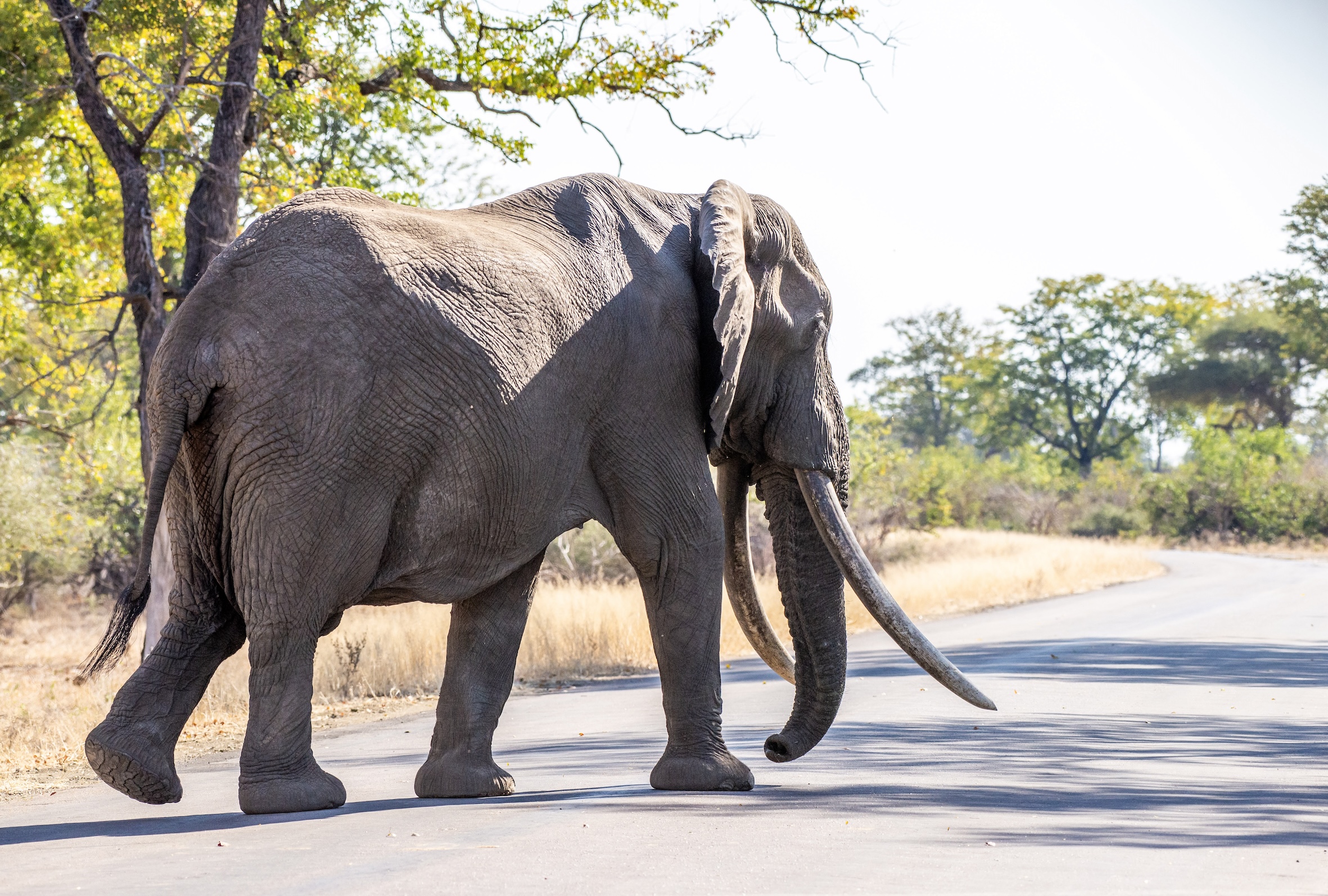A big male tusker in the road outside Shingwedzi camp in Kruger National Park. A government proposal to drop some statutory safeguards for the Kruger National Park has raised the alarm among some experts. Photos: John Yeld
By John Yeld
31 May 2024
Government is proposing to drop statutory environmental impact assessments (EIAs) for some categories of development in the park. The controversial proposal has as yet attracted little response from the public.
But some specialists are warning that the move will reduce the public’s ability to participate in the future management of Kruger and is contrary to the Constitution.
A government proposal to exclude South African National Parks from having to get environmental authorisation for some developments in the Kruger National Park has slipped in almost unnoticed.
Just five responses were received to this proposal that was gazetted by Forestry, Fisheries and the Environment (DFFE) minister Barbara Creecy in mid-February, with a public comment period of 40 days.
But one of those who did respond was a Cape Town lawyer specialising in environmental, heritage and planning law, Richard Summers. In a comprehensive, 10-page comment, he argues the proposed changes will allow South African National Parks (SANParks) to decide on and implement developments without appropriate checks and balances.
“This is in direct contravention of the basic tenets of administrative justice as supported by South African courts,” he writes in his submission.
Summers also points out that protected areas such as national parks are held in trust by the authorities for the benefit of present and future generations, and argues the proposed change will prevent interested and affected parties (IAAPs) and stakeholders from participating meaningfully in decisions regarding activities in the Kruger National Park.
This is at odds with the importance placed on public participation spelled out in Section 33 of the Constitution, he notes, and insists “… any measure that erodes civil society’s ability to meaningfully participate must be rejected”.
His submission was supported by Professors Reece Alberts and Francois Retief, both of the Protected Areas Research Group at North West University.
Exclusions
Environmental Impact Assessments (EIAs) lie at the heart of South Africa’s environmental management regime, coded in legislation under the umbrella National Environmental Management Act (NEMA) of 1998.
Full EIAs are usually required before authorities such as the DFFE can give or refuse approval to developments or “listed activities”. But NEMA does allow for identified activities to be excluded from the requirement of environmental authorisation in certain circumstances – ostensibly to streamline the EIA process, promote efficiency in the system, and reduce costs.
Such exclusions can apply to geographical areas or to activities within existing environmental management regimes that have been identified and formally adopted as “environmental management instruments” in terms of NEMA.
Examples of instruments that have been adopted include:
- a generic environmental management programme for the management and mitigation of environmental impacts resulting from Working for Water projects (February 2021);
- the generic environmental management programme for development projects within the Atlantis urban area (January 2022); and
- phase 1 of the Square Kilometre Array radio telescope in the Northern Cape (March 2019).
DFFE’s latest proposal is to exclude SANParks from having to obtain environmental authorisation before commencing “listed activities” within the Kruger National Park. The proposal includes all activities listed in the park’s Annual Infrastructure Project Implementation Plan; activities related to maintenance; and those related to conservation projects or rehabilitation.
Not included are energy-related projects for which an atmospheric emission licence is required, and waste management activities requiring a waste management licence.
However, there are two important provisions: such activities must take place in accordance with both the zoning scheme set out in the park’s ten-year Management Plan 2018-2028, and with its 58-page Generic Environmental Management Programme which was only published late last year.
Both documents have been adopted as environmental management instruments in terms of NEMA.
The Lilac-breasted Roller is a photographers’ favourite in the Park.
Streamlining decisions
Peter Mbelengwa, DFFE’s chief director of communication and advocacy, confirmed that five sets of comments about the proposal had been received.
“There were no outright objections to the proposal. However, suggestions/inputs were made on aspects of the proposal. Based on the inputs received, amendments have been made to the documents, which will soon be gazetted for a further public commenting period,” he said.
A report would be available on the department’s website once the revised documents have been approved for re-gazetting, Mbelengwa added.
In his comments, Summers acknowledged that the purpose of the proposed regime was to streamline decision-making. But, he said, the park’s management plan “does not offer the requisite scientific and empirical informational basis from which to streamline environmental decision-making in the park which is a strategically important and sensitive area that should not be subject to the risks imposed by the proposed regime.”
The proposal would strip the basis for properly assessing significant decisions about the park, he added.
“The proposed regime therefore runs contrary to those principles of sound environmental management in NEMA, the right to administrative justice …, and the environmental right held in section 24 of the Constitution.”
Lions at night in the Kruger Park.
Biodiversity
Kate Handley, co-founder and executive director of the Biodiversity Law Centre (which has not formally commented on the Kruger Park exclusion notice), described the proposal as “concerning”.
“The purpose of conducting an EIA and having to obtain an environmental authorisation is to ensure that all impacts associated with an activity are thoroughly assessed and, where necessary, mitigation measures proposed,” she told GroundUp.
“Not having to conduct an EIA creates the risk that site-specific impacts are not properly considered, which is deeply problematic in a protected area of exceptional biodiversity value such as Kruger.”
An environmental management instrument was not as fine-scale as an EIA, and this created a risk that important biodiversity features could be overlooked, Handley warned.
“Further, and given the long period for which they remain in place – the Kruger Park Management Plan is for 2018 to 2028 – this makes activities subject only to compliance with the Plan and creates the risk that evolution in the landscape both from an ecological and developmental perspective is not properly accounted for before activities that may have significant impacts are commenced.
She said South Africa should be doing “all we can” to protect our biodiversity, particularly in light of our international commitments, such as the Kunming-Montreal Global Biodiversity Framework in which we’ve committed to protect at least 30% of our inland and marine ecosystems by 2030.
Published originally on GroundUp .
© 2024 GroundUp. This article is licensed under a Creative Commons Attribution-NoDerivatives 4.0 International License.
Follow African Insider on Facebook, Twitter and Instagram
Source: GroundUp
Picture: GroundUp
For more African news, visit Africaninsider.com




